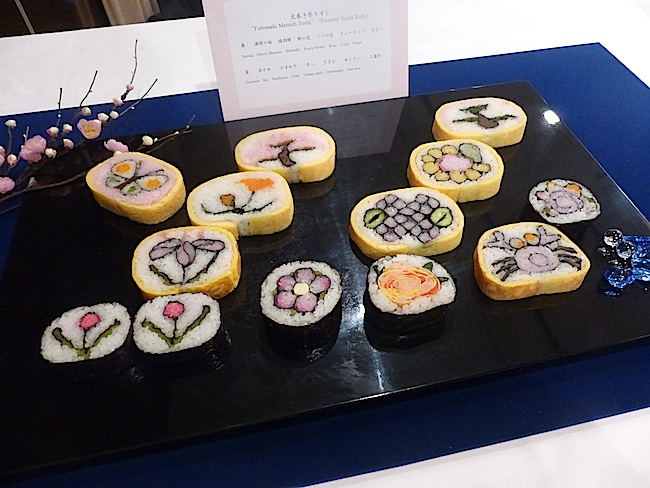
We recently had the opportunity to attend the delightful reception “Celebrating Worldwide Recognition of Washoku and Rice” aimed to present the appeal of rice and its importance in Japanese cuisine (washoku). In our first article covering the event, we gave you a round-up on the talks and demonstrations made by three guest speakers during the first part of the evening’s program, including the serving of a traditional Japanese meal prepared by a master chef. Now, it was time for us to get active and try our hand at a bit of sushi rolling!
In this, the second and final article in this two-part series, we’ll attempt to create a special futomaki sushi roll known as Futomaki Matsurizushi (“thick roll festival sushi”) like the one made by Ms. Eiko Ryuzaki, president of the Chiba Traditional Local Cooking Study Group, in one of the presentations earlier that evening.
Okay, so we weren’t going to be able to create an entire plate of colorful festive futomaki rolls like the display in the picture above, but we were excited about the chance to make even just one pretty little roll! So, were we ready to get our hands sticky with rice? You can bet we were!
Those of us participating in the futomaki making experience were divided into small groups at several tables, with a sushi roll instructor at each table, so we were sure to have expert guidance (which we were sure we would need).
▼When we got to our table, the bamboo mats for rolling the sushi and all the ingredients were neatly laid out for us, including the pink and white vinegared rice. So yes, we had it kind of easy to start with.
▼First we divided the pink rice into five equal portions …
▼… so that we can place it evenly on top of the strip of nori seaweed. There’s a powdered mix available, by the way, that you can easily mix with plain cooked rice to make pink vinegared rice.
▼We then placed a smaller amount of white rice on top of the pink rice and mixed them together evenly.
▼We rolled the rice and seaweed together, rolling the bamboo mat firmly between the palm of both of our hands …
▼… and we repeated the process to make five identical thin rolls (well, some were slightly thicker than others in our case, but in theory, the rolls were supposed to be identical).
▼We then placed pieces of processed cheese in the center of the five rolls, while holding everything on the bamboo mat together in one hand.
▼We also placed long, thin pieces of boiled spinach between each of the rolls. That completes the first part of the futomaki.
▼We then moved on to the second part of the roll, beginning with a fresh sheet of seaweed, onto which we placed plenty of white vinegared rice.
▼The cluster of five thin rolls we made first was then placed inside the large sheet of seaweed and white rice.
▼We made sure the white rice went evenly around the five central rolls.
▼We then firmly rolled everything together into shape.
▼Now all we had to do was cut the roll.
▼Our instructor actually took care of this part, as it can be somewhat difficult to cleanly cut a roll of rice.
▼And here we have part of the completed futomaki — in the pattern of peach flowers! If you saw our first article, this is the same type of roll as the second futomaki Ms. Ryuzaki made in her demonstration earlier that evening.
▼And here’s all of the sushi roll, cut into seven pieces. We were worried about whether we would be able to make a decent looking roll, but we have to say, it turned out better than we had expected (although we had the expert help of our instructor to thank for that). The pink rice gives it such a gentle yet pretty tinge of color!
▼Now, after all that rolling, we were ready to taste a bit of the sake they were giving out at another table.
▼They had two types of the Dassai junmai daiginjo sake (pure rice ultra-premium sake) , the Dassai 23 and Dassai 50.
Junmai daiginjo sake, which is generally considered to be the highest class of sake, is made using only water, koji rice malt and rice, and the rice specifically has to be polished enough to remove at least 50% of the original grain for the sake to be classified a daiginjo. The Dassai 50 is a junmai daiginjyo sake made from rice polished down to 50% of its original size, and the Dassai 23 from rice polished down to 23%. We sampled the Dassai 23, and it was incredibly mild and smooth but not overly sweet.
▼Not surprisingly, people were eager to give the drink a try.
All right, after the informative talks and demonstrations, enjoying a Japanese meal consisting of one soup and three dishes plus beautifully cooked rice, rolling some sushi and tasting a bit of sake, we have to say we were quite happy!
We certainly hope many people around the world have the chance to enjoy fine washoku and sake, whether at a local Japanese restaurant or on a visit to Japan. And the next time you have the chance to have a Japanese meal, perhaps you can keep in mind that while there are many styles and different kinds of Japanese cuisine, one thing that remains a constant is that rice plays a central role. You could very well say that without rice, there is no Japanese cuisine. So here’s to rice, that wonderful grain that is not only a crucial part of our diet but gives us so much pleasure as well — yes, we love you, rice, and we couldn’t live without you!
Photos: RocketNews24




















 Dassai sake matcha truffles bring two esteemed Japanese companies together for limited time
Dassai sake matcha truffles bring two esteemed Japanese companies together for limited time Can you make a proper ehomaki lucky sushi roll with Daiso equipment?
Can you make a proper ehomaki lucky sushi roll with Daiso equipment? Now you can have karinto crackers flavored with popular sake Dassai!
Now you can have karinto crackers flavored with popular sake Dassai! Mos Burger x Dassai sweet sake collaboration expands with new rice burgers and a konjac drink
Mos Burger x Dassai sweet sake collaboration expands with new rice burgers and a konjac drink Japan’s most popular sake brand runs full-page ad asking people to stop paying so much for it
Japan’s most popular sake brand runs full-page ad asking people to stop paying so much for it McDonald’s new Happy Meals offer up cute and practical Sanrio lifestyle goods
McDonald’s new Happy Meals offer up cute and practical Sanrio lifestyle goods All-you-can-drink Starbucks and amazing views part of Tokyo’s new 170 meter-high sky lounge
All-you-can-drink Starbucks and amazing views part of Tokyo’s new 170 meter-high sky lounge McDonald’s Japan releases a pancake pie for new retro kissaten coffeeshop series
McDonald’s Japan releases a pancake pie for new retro kissaten coffeeshop series Starbucks reopens at Shibuya Scramble Crossing with new look and design concept
Starbucks reopens at Shibuya Scramble Crossing with new look and design concept Studio Ghibli glasses cases let anime characters keep an eye on your spectacles
Studio Ghibli glasses cases let anime characters keep an eye on your spectacles Beautiful Sailor Moon manhole cover coasters being given out for free by Tokyo tourist center
Beautiful Sailor Moon manhole cover coasters being given out for free by Tokyo tourist center More foreign tourists than ever before in history visited Japan last month
More foreign tourists than ever before in history visited Japan last month Super Nintendo World expansion gets delayed for several months at Universal Studios Japan
Super Nintendo World expansion gets delayed for several months at Universal Studios Japan Hamster abandoned at Tokyo ramen restaurant gets new home
Hamster abandoned at Tokyo ramen restaurant gets new home Expensive Japanese nail clippers: Are they worth it?
Expensive Japanese nail clippers: Are they worth it? Disney princesses get official manga makeovers for Manga Princess Cafe opening in Tokyo
Disney princesses get official manga makeovers for Manga Princess Cafe opening in Tokyo Beautiful new Final Fantasy T-shirt collection on the way from Uniqlo【Photos】
Beautiful new Final Fantasy T-shirt collection on the way from Uniqlo【Photos】 Is the new Shinkansen Train Desk ticket worth it?
Is the new Shinkansen Train Desk ticket worth it? Foreign English teachers in Japan pick their favorite Japanese-language phrases【Survey】
Foreign English teachers in Japan pick their favorite Japanese-language phrases【Survey】 Japanese convenience store packs a whole bento into an onigiri rice ball
Japanese convenience store packs a whole bento into an onigiri rice ball We try out “Chan Ramen”, an underground type of ramen popular in the ramen community
We try out “Chan Ramen”, an underground type of ramen popular in the ramen community Studio Ghibli releases Kiki’s Delivery Service chocolate cake pouches in Japan
Studio Ghibli releases Kiki’s Delivery Service chocolate cake pouches in Japan Japan’s bone-breaking and record-breaking roller coaster is permanently shutting down
Japan’s bone-breaking and record-breaking roller coaster is permanently shutting down New definition of “Japanese whiskey” goes into effect to prevent fakes from fooling overseas buyers
New definition of “Japanese whiskey” goes into effect to prevent fakes from fooling overseas buyers Our Japanese reporter visits Costco in the U.S., finds super American and very Japanese things
Our Japanese reporter visits Costco in the U.S., finds super American and very Japanese things Studio Ghibli unveils Mother’s Day gift set that captures the love in My Neighbour Totoro
Studio Ghibli unveils Mother’s Day gift set that captures the love in My Neighbour Totoro Foreign passenger shoves conductor on one of the last full runs for Japan’s Thunderbird train
Foreign passenger shoves conductor on one of the last full runs for Japan’s Thunderbird train Domino’s Japan now sells…pizza ears?
Domino’s Japan now sells…pizza ears? New Japanese KitKat flavour stars Sanrio characters, including Hello Kitty
New Japanese KitKat flavour stars Sanrio characters, including Hello Kitty Kyoto creates new for-tourist buses to address overtourism with higher prices, faster rides
Kyoto creates new for-tourist buses to address overtourism with higher prices, faster rides Sales of Japan’s most convenient train ticket/shopping payment cards suspended indefinitely
Sales of Japan’s most convenient train ticket/shopping payment cards suspended indefinitely Sold-out Studio Ghibli desktop humidifiers are back so Totoro can help you through the dry season
Sold-out Studio Ghibli desktop humidifiers are back so Totoro can help you through the dry season Japanese government to make first change to romanization spelling rules since the 1950s
Japanese government to make first change to romanization spelling rules since the 1950s Ghibli founders Toshio Suzuki and Hayao Miyazaki contribute to Japanese whisky Totoro label design
Ghibli founders Toshio Suzuki and Hayao Miyazaki contribute to Japanese whisky Totoro label design Doraemon found buried at sea as scene from 1993 anime becomes real life【Photos】
Doraemon found buried at sea as scene from 1993 anime becomes real life【Photos】 Tokyo’s most famous Starbucks is closed
Tokyo’s most famous Starbucks is closed One Piece characters’ nationalities revealed, but fans have mixed opinions
One Piece characters’ nationalities revealed, but fans have mixed opinions We asked a Uniqlo employee what four things we should buy and their suggestions didn’t disappoint
We asked a Uniqlo employee what four things we should buy and their suggestions didn’t disappoint Princesses, fruits, and blacksmiths: Study reveals the 30 most unusual family names in Japan
Princesses, fruits, and blacksmiths: Study reveals the 30 most unusual family names in Japan Takoyaki sushi rolls at popular Japanese chain take California rolls to a whole new level
Takoyaki sushi rolls at popular Japanese chain take California rolls to a whole new level Foo Fighters unveil an exclusive new Japanese sake
Foo Fighters unveil an exclusive new Japanese sake Rainbow sushi: a colorful twist on everybody’s favorite roll 【Pics】
Rainbow sushi: a colorful twist on everybody’s favorite roll 【Pics】 We try dessert sushi (with a French twist!)【Recipe】
We try dessert sushi (with a French twist!)【Recipe】 A feast for all sushi lovers — the amazing 1,000-yen lunch at Sushi Takehan Wakatsuki!
A feast for all sushi lovers — the amazing 1,000-yen lunch at Sushi Takehan Wakatsuki! Is that restaurant in Tokyo with the giant mecha crab sign any good?
Is that restaurant in Tokyo with the giant mecha crab sign any good? Learn how to make sushi with a professional Japanese sushi chef in Tokyo
Learn how to make sushi with a professional Japanese sushi chef in Tokyo Starbucks starts selling sushi in America, calls it a “burrito” and “sandwich” for some reason
Starbucks starts selling sushi in America, calls it a “burrito” and “sandwich” for some reason A collection of 20 creative ‘sushi’ rolls that were invented outside of Japan
A collection of 20 creative ‘sushi’ rolls that were invented outside of Japan Our reporter dishes on the differences between sushi from Ginza Kyubey and Sushiro【Taste test】
Our reporter dishes on the differences between sushi from Ginza Kyubey and Sushiro【Taste test】 The best place to eat Japanese breakfast for US$2: Cheap food hack for locals and tourists
The best place to eat Japanese breakfast for US$2: Cheap food hack for locals and tourists Kura Burger: Japanese sushi chain restaurant offers burgers in Tokyo for a limited time
Kura Burger: Japanese sushi chain restaurant offers burgers in Tokyo for a limited time Sushi chain bento combines raw fish with…sukiyaki?
Sushi chain bento combines raw fish with…sukiyaki? We try black rice sushi rolls in Australia
We try black rice sushi rolls in Australia We spend a morning with an expert wagashi chef creating no-bake traditional Japanese sweets!
We spend a morning with an expert wagashi chef creating no-bake traditional Japanese sweets! Sukiyabashi Jiro Sushi Rice: How good is rice from Japan’s legendary sushi restaurant?
Sukiyabashi Jiro Sushi Rice: How good is rice from Japan’s legendary sushi restaurant? How to have a great meal at conveyer belt sushi chain Kura Sushi even if you hate raw fish
How to have a great meal at conveyer belt sushi chain Kura Sushi even if you hate raw fish
Leave a Reply